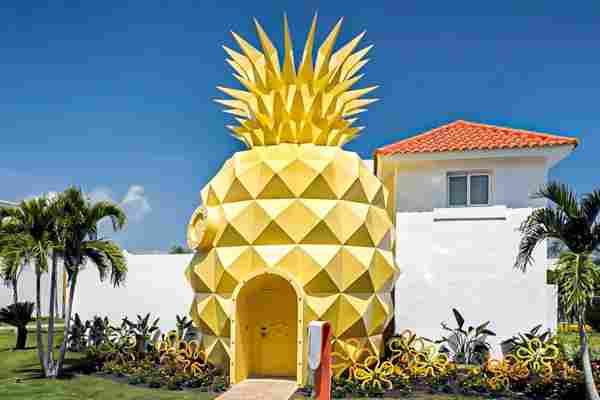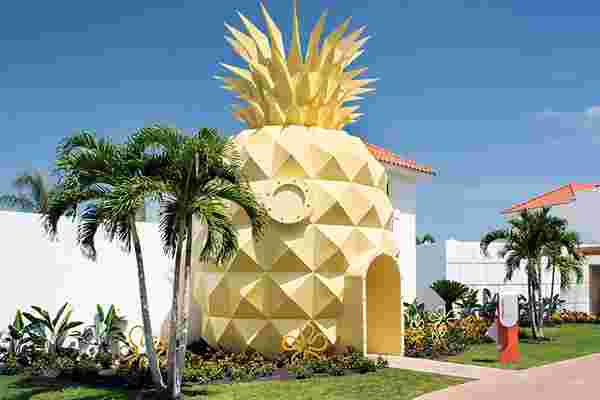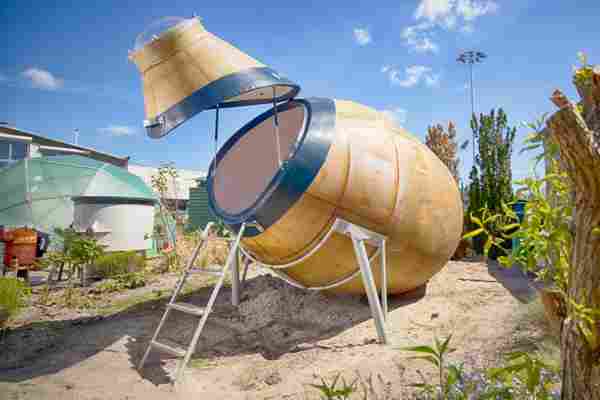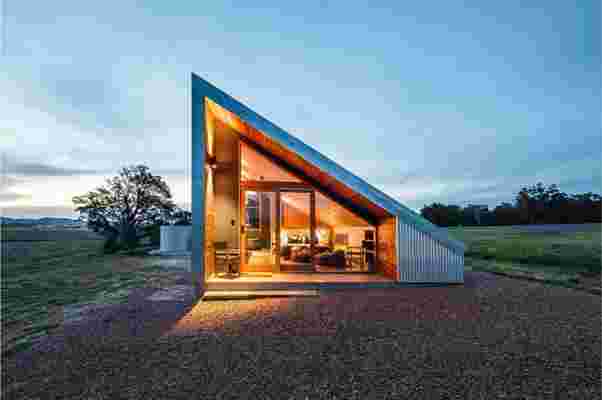
What is helping me get by these trying times is thinking about all the things I would do or places I will visit once the pandemic ends. Somewhere in the middle of all the wishful thinking and watching cartoons, I came across Spongebob’s Pineapple Villa and I had to look at it thrice to make sure my mind was not playing tricks on me. I can confirm it is real, the Pineapple from Bikini Bottom is actually a part of Nickelodeon’s resort in Punta Cana, and friends, that is where I want to be relaxing if we get our summer back. Welcome to Home Sweet Pineapple!
I will happily trade 124 Conch Street for a vacation in the Dominican Republic. The Pineapple Villa is not an exact replica of our beloved sea sponge’s home but, it is a lot more luxurious and human-friendly! The decor inside the villa has many iconic elements of Spongebob’s humble abode to make you feel like you are in Bikini Bottom – like the blue bamboo wallpaper, the floaty chair, the bulls-eye window, and the diving-helmet shaped tv. It has a private master suite with a king-size bed, both indoor and outdoor living as well as dining areas, and a complete marble bathroom. But my favorite part about the pineapple under the sea (or on land in this case) is the Aguas del Amor outdoor shower and freestanding tub. If that wasn’t enough, you can stroll through the villa’s private gardens, the Pineapple’s very own infinity pool or lounge on the sun-bathing beds while enjoying some of the show’s famous burgers. Anything outdoor that comes with butler-service at this point has my full attention.
“The 2-bedroom/3-bath Pineapple features all of the modern amenities and luxurious accommodations found in the Super Villas, but with a unique twist: all who enter are instantly immersed in SpongeBob’s world,” say those managing the iconic yellow structure. What makes me feel warm inside (yes, I realize I feel that way for a cartoon) is that this is probably the life Spongebob dreamed of having instead of flipping burgers. But what I do know for sure is that he would bury himself in the sand before he coughed up $3,800 per night.
Designer: Nickelodeon

Dutch architects upcycle waste into sustainable glamping pods!

The pandemic has given a boost to road trips, local travel, and camping as borders remain shut and air travel increases risks. The easiest way to catch your breath, take a break, and spend time away from home while rejuvenating is to go to a local camping ground! While looking at interesting campsites I found Culture Campsite which was designed by architects to be an urban oasis filled with quirky pods that will give you the escape you’re craving while not ‘wasting’ any resources or time!
A team of Dutch designers and artists transformed a concrete parking lot in Rotterdam’s Delfshaven area into a sustainable urban camping ground making it more accessible for people. There is a range of cool architectural cabins to choose from and they are all built using upcycled and waste stream materials. The idea was to show not tell – this way people could experience living in a sustainable structure themselves and find that it can be incorporated into their lifestyle! The pods are all smaller than a tiny house but way more exciting than a tent because of their unique builds and each of them showcases innovative sustainable elements. Every cabin offers a special experience and my favorite one is the Val Ross cabin because it reminds me of the rocket emoji (yes, I am a space nerd!). Val Ross is Swedish for walrus and is constructed from old animal silos which are tall towers used to store food on a farm. It has one bedroom with a double-bed which is comfortable for 1-2 people. The cabin is insulated for the colder seasons and has a cool circular window like we imagine rockets to have!
“The principle of waste architecture is designing and sketching with the materials and objects that are available. Playing with form, material, and color leads to new insights and forms that cannot be imagined on a white sheet of paper. It requires a different way of designing to change, adapt and merge existing forms,” says Boris Duijenveld, founder of Mud (Mobile Urban Design) Projects and one of the designers from the artistic collaboration that gave us Culture Campsite. Meals will be served at the geodesic done and, yes, there is a communal bathroom area for your other needs. You can also enjoy yoga classes, outdoor activities, and a multi-day course on tiny house design so you can come up with your own sustainable cabin! It is surely different from a traditional camping trip and gives you a little Narnia moment in the city where you can escape to from time to time.
Designer: Mud Projects

This 40sqm sustainable tiny home built using repurposed materials features a 30-degree solar-paneled roof!
{"title":"NEVER TOO SMALL 40sqm/430sqft Tiny Cabin - Gawthorne's Hut","author_name":"NEVER TOO SMALL","author_url":"https://www.youtubeom/c/NEVERTOOSMALL","type":"video","height":"591","width":"1050","version":"1.0","provider_name":"YouTube","provider_url":"https://www.youtubeom/","thumbnail_height":"360","thumbnail_width":"480","thumbnail_url":"https://i.ytimgom/vi/uVOSWV_SzmA/hqdefault.jpg","html":"<iframe width="1050" height="591" src="https://www.youtubeom/embed/uVOSWV_SzmA?feature=oembed" frameborder="0" allow="accelerometer; autoplay; clipboard-write; encrypted-media; gyroscope; picture-in-picture" allowfullscreen></iframe>","arve_cachetime":"2021-08-03 22:34:29","arve_url":"https://youtu.be/uVOSWV_SzmA","arve_srcset":"https://i.ytimgom/vi/uVOSWV_SzmA/mqdefault.jpg 320w, https://i.ytimgom/vi/uVOSWV_SzmA/hqdefault.jpg 480w, https://i.ytimgom/vi/uVOSWV_SzmA/sddefault.jpg 640w, https://i.ytimgom/vi/uVOSWV_SzmA/maxresdefault.jpg 1280w"}
Built with an angled roof, the galvanized clad tiny home accommodates travelers near and far who want to get closer to rural Australia.
The tourism industry has seen some major changes in sustainability in recent years. Hospitality companies like Airbnb and homeowners alike work together to progress tourism into an industry that doesn’t disrupt pre-existing landscapes and cultures but embraces them. Gawthorne’s Hut in New South Wales, a tiny home in Australia available on Airbnb , is one example of sustainable hospitality. Designed by architect Cameron Anderson, the two-person, off-grid tiny home was built to engage with the history and context of the farmland on which it’s located.


Gawthorne’s Hut is stationed on an expansive plot of Wilgowrah’s farmland, right beside a small, quaint pond. The tiny home was born out of Wilgowrah’s desire to introduce the possibilities of alternative income sources for farmworkers. Designed in a similar form to other farmland structures like hay sheds and outbuildings, Gawthorne’s Hut’s 30-degree roof hosts an array of north-facing solar panels to provide the farmhouse with internal and external power.
Since the project aimed to create a sustainable, off-grid tiny home, Anderson needed to get the solar panels’ orientations facing a direction where the greatest output could be stored for use. The solar panel roof angles at 30-degree and faces the north to acquire the most solar output. With the solar panels facing the farm’s north side, double glazed timber windows and doors direct the views to the farm’s south end and offer natural ventilation on hot days as well as insulation for the colder nights.
Architect Cameron Anderson took to the farm’s preexisting and surrounding material to curate the array of building material for Gawthorne’s Hut. In addition to the solar panels, the home keeps a 6.6-kilowatt off-grid solar system containing 12 kilowatts of battery storage behind a large opening panel that remains hidden from view when closed. Rainwater storage systems also collect 40,000 liters worth of rainwater, 20,000 of which are allotted for firefighting.
Leaning on sustainable energy practices like the use of solar panels, passive solar shading, and even the thermal mass that comes from the floor’s polished concrete slabs, each work together to position Gawthorne’s Hut as an eco-friendly tourist destination with views of Australia you can’t get anywhere else.
Inside, rich and textured timber panels stretch over the walls and ceilings, giving Gawthorne’s Hut a cozy, nesting atmosphere. Gawthorne’s Hut’s micro floor plan of 40m2 feels larger than its measurements thanks to an open floor plan that extends throughout the home, with the one exception being the WC. Throughout the tiny home’s interior, repurposed bricks and rich timber panels line the walls, ceiling, and furnishings. The king-sized bed’s head post, for example, was handcrafted from recycled brick leftover from the lot’s previous building.
Stationed beside a small pond, the tiny home is as quaint as it gets. Repurposed brick from previous farm structures divide the different spaces inside Gawthorne’s Hut – the bed’s headboard doubles as a wall for the basin. Simple, unique, and cozy – this tiny home grows beyond its tiny design.
Designer: Wilgowrah , Cameron Anderson , & Callander Constructions
The design of Gawthorne’s Hut is meant to be intuitive, so the kitchen was kept small and filled with only the essentials.
A wood-burning fireplace welcomes guests into the tiny home and immediately fills the home with a cozy ambiance.
The toilet room is the only section inside of Gawthorne’s Hut that incorporates a door and dividing wall.
Polished concrete slabs line the floor and walls of the shower and bath areas.
The solar-paneled roof provides the home with enough energy to power up the minimal appliances needed to enjoy a stay in NSW’s back country.
Hidden away inside the home’s exterior side-opening panel, a solar system and battery pack insure the home with stored power.
The king-sized bed is located closer to the tiny home’s vertex to enhance an already intimate sleeping experience.








